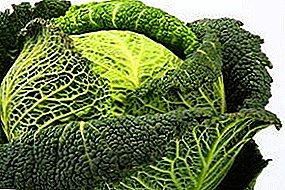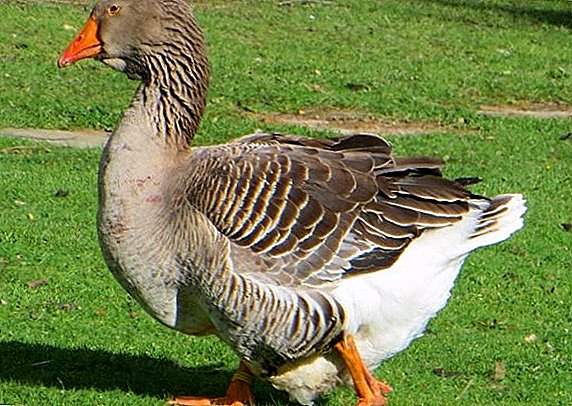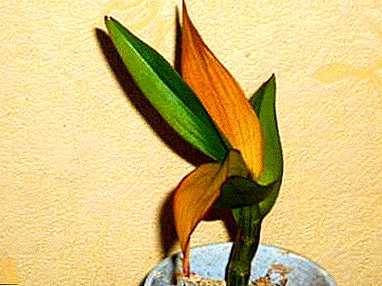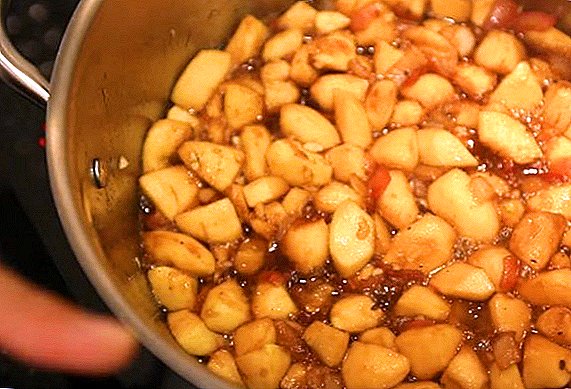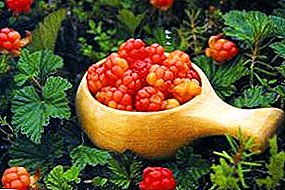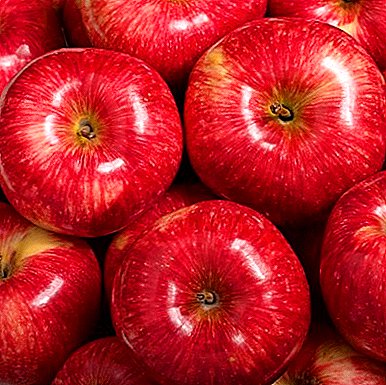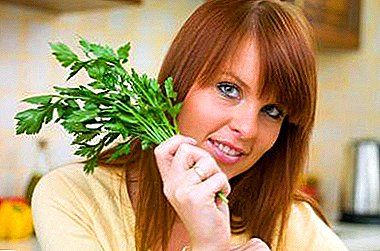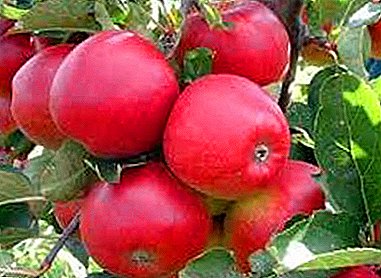
Probably, the choice of varietal name for this crimson apple in its maturity was not without associations with the Greek goddess of love.
Or maybe breeders recalled the myth of the "apple of discord", but one way or another, since 1981 it appeared in the collection of the Research Institute of Fruit Crops under the catchy name Aphrodite.
The description of the apple variety Aphrodite and the photo of its fruit - hereinafter.
What kind is it?
 The duration of the active life of a new variety usually does not exceed 300 years. There are, however, varieties of long-lived - Aport, eg. He is already 900 years old. And Calvil Snow and even more - 2000 years.
The duration of the active life of a new variety usually does not exceed 300 years. There are, however, varieties of long-lived - Aport, eg. He is already 900 years old. And Calvil Snow and even more - 2000 years.
In our country, varietal selection took up relatively recently - in the early 20th century. Therefore, many habitual apple trees in gardening go in the description with the note: "national selection".
Apple tree Aphrodite - new table grade winter-hardy applewhich tests took place within 25 years in the territory Central Chernozem Region and region Lower Volga.
Creating a new variety is not an end in itself; specialists are purposefully working to give the plant new properties and qualities that are useful to man:
- resistance to climatic features of the region (winter resistance, drought resistance);
- confrontation to specific diseases;
- acceleration of fruit ripening;
- increased fertility;
- reduction of terms of readiness for fruiting;
- improvement of commodity attractiveness of fruits;
- improving the chemical composition of the pulp;
- changing morphological characteristics with the aim of effective care.
In the course of the breeding work, the apple variety Aphrodite acquired a new immune gene (Vf) that makes the plant immune to 5 races of the fungal disease, destructive to apple trees, scab. Thus, the merits of the new variety obtained from seedlings in free pollination were consolidated, although this required many years of effort.
Also resistant to scab have varieties: Daughter Pepinchik, Uralets, Yubilyar, Stroyevsky and Rennet Chernenko.
Virtues of apple

- Winter hardiness in the European part of Russia.
- Eliminate the need for additional means of protecting the tree before winter.
- Resistance of the root system to the proximity of groundwater.
- High yield (278 c / ha).
- Annual fruiting.
- Immunity to scab.
- High quality fruits (commercial and consumer).
- Chemical complex of substances that contribute to the prevention and improvement of the human body.
- Suitability for long-term storage of fruits (until January at 0 degrees) and transportation.
Disadvantages during the 25-year test varieties were not identified.
Also high yields are different varieties: Gala, Antey, Welsey, Quinty and Bratchud.
Description varieties Aphrodite
Like many apple trees, Aphrodite - self-infertile variety. For full and abundant fruiting he needs a partner pollinator.
A suitable choice of pollinators for this variety is small: Stroyevskoe (winter variety of later breeding) and Kurnakovskoe (elite variety; in the State Register since 2002).
And the latter, in the process of pollination itself expects the reciprocity of Aphrodite.
 However, both partner trees meet the main requirements for pollinators:
However, both partner trees meet the main requirements for pollinators:
- they have common flowering and fruiting periods with Aphrodite;
- they refer to the winter form of apples;
- resistant to scab;
- have the same lifespan and productivity.
Reference: Since the main carriers of pollen are bees, and the radius of their flight does not exceed 2 km, the pollinator tree must be located within this zone.
- Aphrodite refers to the earliest winter varieties, but the "keeping capacity" of its fruits does not exceed 3 months. The full ripeness of apples (consumer), comes only after harvesting (2-3 weeks later), which falls on the second half of September.
- Reproductive functions of the plant manifests from 4-5 years. At productive age gives 150 kg of fruit from one stem. Terms of life in the general limits for apple trees - 50-60 years.
- This grade characterizes annual high productivity, without the periods of recession.
- Winter hardiness of this apple tree is manifested in tolerance to temperature differences of the Russian winter, with its thaws and frosts.
- During the breeding variety is insured from the damaging effects of fungal diseases.
- Apple Aphrodite as a table variety is consumed fresh and can be processed into dried fruits, juices, compotes, preserves, jams, marmalade, fruit wine - cider.
Special benefits for humans can boast varieties: Orlinka, Orlovsky pioneer, Moscow winter, Aromatic and Young Naturalist.
A photo




External data
Consider separately the appearance of the apple and its fruit.
Large fast-growing trees have a not too thick rounded crown. Feature: skeletal branches are formed at right angles to the trunk.
Young shoots with a light edge curved arc and have a brown color. The bark of an adult tree is greenish-brown, smooth.
Before flowering on the branches, small buds pressed to the shoots can be seen. Flowers will appear from those that are larger, in the form of umbrella inflorescences with 4-6 flowers in each.
 In the buds, the flowers have a pale pink color, having opened, they become even lighter. The size of flowers is average, in shape resembles a saucer, in the center of which are fused pistils and anthers 10–20 stamens.
In the buds, the flowers have a pale pink color, having opened, they become even lighter. The size of flowers is average, in shape resembles a saucer, in the center of which are fused pistils and anthers 10–20 stamens.
Leaves appear together with flowers, but due to slow growth they allow flowers to dominate in the crown during the flowering period before the formation of the ovary.
Finally, having formed, the leaves reach an average size with an oblong shape. Color have a dark green with a yellowish tinge. The lamina from the back side is slightly pubescent, the edge is wavy, the stem is proportional.
Apples are distinguished by their decorative effect: the greenish-yellow peel is mostly covered with striped crimson blush, which becomes even brighter at the time of consumer maturity.
The fruit is small, up to 140 grams, with shiny smooth skin and a characteristic oily sheen. Seed chambers closed, conical seeds, medium size, brown in color.
Varietal pulp feature - pink streaks in white dense structure. Apple Aphrodite is famous for its juiciness and sweet-sour taste.
Growing points
 In fact, this variety does not claim exceptional growing conditions. The sunny side, protected from strong winds, it is quite satisfied.
In fact, this variety does not claim exceptional growing conditions. The sunny side, protected from strong winds, it is quite satisfied.
The main thing that Neighbors in the garden are not crowded, it was where to grow, Yes the ground was not swamped. Therefore, it is not necessary to plant an apple tree in the lowlands in which water does not melt for a long time after melting snow or rain. Although the ground water Apple tree endures tolerant.
You should not use a place where another apple has grown old, and planting next to the house is not practical: windfalls, flies, leaf litter.
It is reasonable to plant different types of apple trees on the plot: a couple of summer, a couple of autumn and winter variety. Then the family all summer and winter will be with vitamins.
Important: Young trees should be planted at a distance from the old ones, so that the branched root system of the latter, intertwining, does not oppress the sapling.
Landing technology
The abundance of future harvests directly depends on the correct selection of seedlings and the exact observance of planting technology.
Therefore:
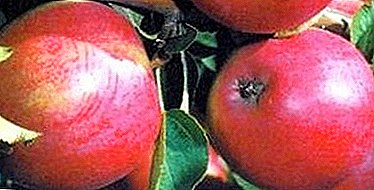 buy seedlings only from trusted suppliers who have licenses and certificates for products;
buy seedlings only from trusted suppliers who have licenses and certificates for products;- Pay attention to the packaging of planting material (ideally - it will be from wet peat), it should not be dried, have leaves;
- beware of seedlings "in exchange" with neighbors and unfamiliar people: you can bring an infection or pests into your garden;
- for reliable engraftment plant two and three years.
Important: Dried roots and broken shoots must be pruned; leaves without damaging the kidneys, carefully remove; cut off the top of the head by 10 cm, leaving 6-7 productive kidneys.
The planting process should be planned for spring (late April) or autumn (no later than the 20th of October). If there is an unforeseen delay in planting the seedling, it is wiser to prikopat for the winter, and plant in the spring. For planting apple varieties of this variety are suitable for a variety of characteristics.
Important: Pit under the seedling harvested a week before the planned planting.
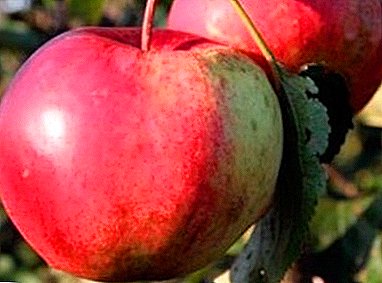 Standard pits - 1 m (diameter) at 0.7 m (depth);
Standard pits - 1 m (diameter) at 0.7 m (depth);- in the process of planting organic fertilizers are applied;
- they mix with loose ground and form into a mound;
- spread the roots of the rootstock along the mound;
- prudently hammered into the center of the pit, the stake provides support for a couple of years for a weak tree;
- the roots are covered with earth, which is trampled down;
- root neck protrudes 5 cm above the soil level;
- the seedling is watered abundantly until the soil is clearly wetted (bucket 5);
- pristvolny circle mulch peat (5 cm) or humus;
- watering is repeated at weekly intervals.
Care system
The care system consists of mandatory seasonal activities:
- loosening and watering;
- pruning branches;
- root fertilization;
- prevention of probable biological damage.
Watering is done 5 times per season, in the hot summer - more often.
Moisten the ground under the apple tree in several ways, but always only in the evening:
- pouring near-trunk circles (3 buckets each);
- sprinkling (moistened and cleaned from dust and insects crown);
- through the device of the furrows around the trunk;
- drip irrigation (for arid areas).
Important: Watering for greater efficiency needs to begin with loosening, using crowbar or forks for this purpose, in order to pierce the soil in several places by 30-40 cm.
Pruning always precedes the main vegetative periods of a plant’s life and pursues several goals:
- trunk formation;
- crown formation;
- sanitary pruning;
- pruning to increase yields;
- for the rejuvenation of wood;
- to prepare for the winter.
 It is possible to manage the future harvest, stimulating fruiting, during the flowering period: To do this, thin the ovary, removing the flowers in the center of the bundle or leaving 1-2 ovaries in the bundle.
It is possible to manage the future harvest, stimulating fruiting, during the flowering period: To do this, thin the ovary, removing the flowers in the center of the bundle or leaving 1-2 ovaries in the bundle.
Apple fertilizer is carried out throughout its productive life and is regulated by the main seasonal phases.
Organic and Mineral (phosphate and potash) substances are introduced in liquid or granular form in exact proportions, according to a special scheme. For the Aphrodite variety, this procedure is no different from the general approach to root feeding of apple trees.
Prevention of probable biological damage from fungal spores is incorporated in a variety already during the selection period. From insect pests can protect the trunk of whitewash (young trees - with chalk, old - lime).
But the main concern of gardeners remains protection of the trunk of the apple tree against the raids of rodents (mice and hares). The tree is protected from them by tying the trunk with fir branches, parchment or roofing felt (on a layer of burlap).
How to save the crop?
 Early winter varieties of apples can be stored for up to 3 months in the refrigerator.
Early winter varieties of apples can be stored for up to 3 months in the refrigerator.
But, if there is a basement and the harvest is great, then lay it on storage is necessary according to certain rules:
- prepare crates without gaps (rinse with a brush, dry);
- cover them with clean paper;
- Do not shift the fruits one by one, but carefully pour them from the bucket in which they were collected, bending it as low as possible to the bottom of the box and holding it with your hand;
- the amplitude of the fall will be the smallest and safe for the preservation of apples;
Important: Apples for storage harvested with the stalk.
- they must stand in a shade or in a cool room for several days before moving to the cellar to cool and sort;
- in the box the fruits are placed in one layer; if in two - you need to rewrite the layers with paper or pour dry chips;
- for long storage, the apples are wrapped individually with clean paper;
- the preferred temperature for storage is 0-3 degrees Celsius, humidity is 80-90%;
- You should not put them in the part of the cellar, where the roots are stored, so that the fruits do not lose their original taste and aroma.
The following apple varieties are well and long kept: In memory of Michurin, Korah, Kutuzovets, Ekranny and Granny Smith.
Useful tips

- Choose seedlings with large, healthy-looking roots.
- Grade Aphrodite is especially photophilous, well, if the sun will illuminate it all day
- The spreading shape of the crown requires a thoughtful placement of the tree in the garden.
- In order to ease the harvesting, you need to adjust the height of the tree by trimming, without limiting the growth of branches horizontally.
- With the growth of a tree, not only the trunk, but also the lower branches should be protected from rodents.


 buy seedlings only from trusted suppliers who have licenses and certificates for products;
buy seedlings only from trusted suppliers who have licenses and certificates for products; Standard pits - 1 m (diameter) at 0.7 m (depth);
Standard pits - 1 m (diameter) at 0.7 m (depth);